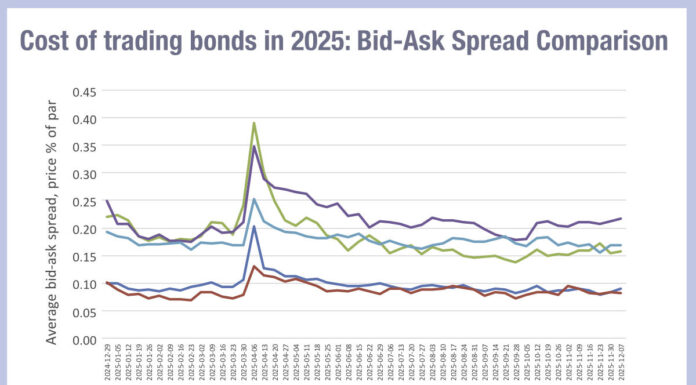Sitting next to the US in the current trade war meant that Mexico avoided the highest bracket of US tariffs, thanks to its existing trade agreement, the United States–Mexico–Canada Agreement (USMCA), with its northern neighbour and an existing set of import levies. However, its status as an ‘investment grade’ (IG) issuer is at risk in the long term, say bank analysts, which would impact investment and trading in the Latin American giant’s debt.
Bank of America (BofA) analysts, following a meeting they had with government officials in Q1 2025, noted that Mexico’s activity will be impacted in an “important” way from tariffs and that Mexico is likely to face recession after higher tariffs are imposed.
“In relative terms Mexico is still the country with the lowest effective tariff, along with Canada, to send goods to the US market, thanks to the USMCA, which is positive for the medium term – we estimate the tariff is about 7.8% now and will likely be reduced to about 5% in the following months,” they wrote. “Nonetheless, Mexico’s potential may have taken a hit.”
Although Moody’s downgraded the country’s outlook from ‘Stable’ to ‘Negative’ in November 2024, ahead of its 2025 Budget announcement, creating consternation, in April 2025, other agencies including Fitch Ratings affirmed Mexico’s long-term foreign currency ‘Issuer Default Rating’ (IDR) would remain at ‘BBB-‘ with a ‘Stable Outlook’.
“These ratifications of sovereign debt will allow the country to continue to have favourable access to national and international financial markets,” said the Government of Mexico in a statement. “The Ministry of Finance and Public Credit reiterates its commitment to the stability of public finances and to a sustainable debt trajectory.”
Yet concerns persist around its rating as its economy is damaged by US trade tariffs, risks in its fiscal policy, and risks in the economy’s capacity to manage headwinds while enabling effective change.
“Overall, we think that rating agencies will see the [new] budget as reasonable, as outlined by our economists,” wrote Simon Waever, global head of emerging market sovereign credit strategy at Morgan Stanley, in November 2024, after the country’s 2025 budget was published. “The focus is now on executing the budget, in particular the spending cuts, and then monitoring the growth impact from the ongoing slowdown in addition to renewed risks due to trade. Of note, Moody’s surprised by moving Mexico to a negative outlook just ahead of the budget announcement. At Baa2 with a negative outlook, we expect the agency to be on hold for the next six months at least to monitor the prior points. That said, unless growth really surprises to the upside, we do think that Moody’s will eventually downgrade later in 2025 due to the expectation of our economists that there is no structural fiscal consolidation, with 2026 fiscals set to widen again. Negative outlooks from Fitch and S&P are possible in 1H25 depending on fiscals and growth performance, in our view.”
Investor confidence
BofA’s assessment of investor sentiment is that the central bank of Mexico, Banxico, is perceived to have space to cut rates below where the current market is pricing, which are 175bp of cuts in the next 12 months, with a terminal rate at 7.25%. BofA is predicting a terminal rate of 7.00%.
Morgan Stanley’s LatAm analysts, meanwhile, note that ratings only matter for a “subset” of countries in the region, however, both Panama and Mexico sit in this bucket.
“Panama is the immediate country at risk of being downgraded to HY and fiscals are a key part of this, in particular the pension costs. For now our base case is that Moody’s downgrades to Ba1 in 2H25. Mexico is the other credit at risk of losing IG but, given the starting point on debt, we think that it has a few years to show improvement in fiscals before this becomes a higher risk.”
On that point, BofA say that the fiscal target set for Mexico this year is “doable”, but facing low growth the country will find 2026 harder going, alongside spend on the country’s oil giant, Pemex, with no clear plan to tackling the issue.
The 2025 budget in Mexico set out that transfers would be made to Pemex to support its 2025 bond and bank loan maturities, mirroring what took place in 2024.
“For 2025 the amount has been set at US$7.4 billion, compared to US$8.5 billion in 2024,” write Morgan Stanley’s analyst team. “This compares to total Pemex debt payments of around US$8.9 billion in 2025 according to the 3Q24 quarterly financial results, of which US$4 billion is external bonds. We see this treatment of Pemex as only a mild disappointment as it didn’t provide any additional help to potentially deal with capex, as we noted was possible in our preview. However, as also noted in the preview, this was not the place to announce any larger change in how Pemex debt will be dealt with in 2025, for instance via liability-management operations or guarantees. We still think that this is only likely later in 2025.”
The bond market
While Mexican bond issuance has been increasing over time, it has also faced a withdrawal of buying activity from overseas investors.

“Foreign ownership of local bonds declined from ~60% at its peak to ~30% currently for a variety of reasons including policy uncertainty and changes in emerging market (EM) bond index composition,” noted Ioana Zamfir, head of Latam macro strategy at Morgan Stanley, in a recent paper.
“Mexico’s metrics became a more pressing concern for markets in late 2023, when the 2024 budget was released ahead of the country’s election year … most investors that we speak with (both domestic and offshore) acknowledge that fiscal risks remain live, but also that it is not an area of focus at the moment, especially given uncertainty about US policymaking and recession risks in Mexico,” she continued.
More broadly across LatAm, foreign participation is estimated to have to declined from an average of 30% prior to 2020 to around 15% currently, giving Mexico a higher participation rate than its local peers.
The local buffer has been helped by reform to Mexico’s pension system which is estimated to reach contributions of around US$23 billion by 2030 against US$9 billion in 2023, based on bank estimates.
That supports greater overall liquidity formation in the market, as does the increased issuance.
The risk of a downgrade
A move from IG to high yield (HY) – even if the risk is not immediate – would trigger Mexico to be dropped from certain investment portfolios, necessitating large directional trades which would be well signalled, making it harder to manage trading costs on buy-side trading desks, and creating investment opportunities for traders with more flexible mandates.
Brazil, Latin America’s largest economy, already trades government debt as HY and has a lower fiscal risk premia according to Morgan Staney analysis.
The improvement in local investor market participation, driven by the increased assets under management (AUM) that pension funds would have through new participation rules, will support price and liquidity formation to some extent.
Additionally, higher levels of electronic trading via e-trading platforms are enabling liquidity formation for a more diverse range of market participants into the Mexican debt markets, reducing reliance on direct dealer-client relationships.
©Markets Media Europe 2025















